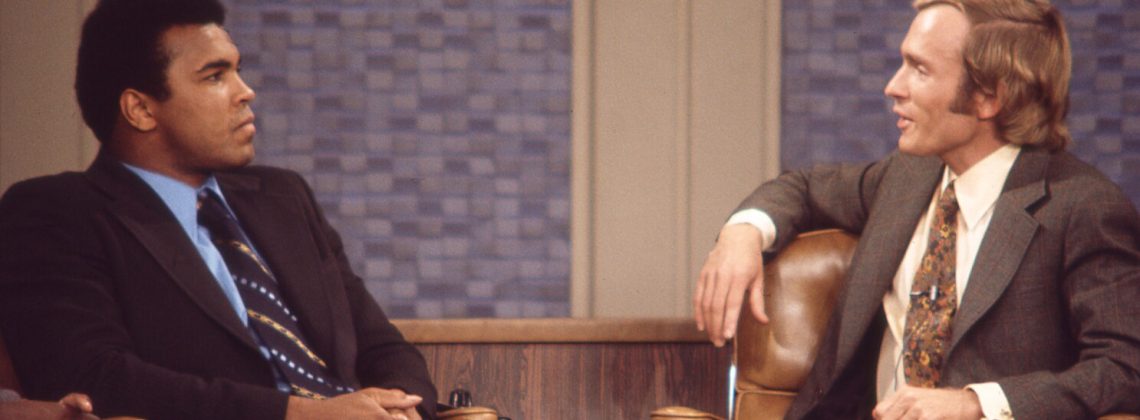

Over at Literary Review of Canada James Brooke-Smith reflects on the lost art of public conversation. Here is a taste of his piece, “Where’s Johnny?“
Executives at ABC tried to scotch the first episode of The Dick Cavett Show before it was broadcast in March 1968, because “nobody gives a shit what Gore Vidal or Muhammad Ali think about Vietnam.” Thankfully, Cavett and his team stuck to their guns; as it turned out, audiences eagerly wanted to hear what Vidal, Ali, and their fellow guest that evening, Angela Lansbury, had to say about the Vietnam War — and about their childhoods, careers, tastes in clothing, favourite holiday destinations, opinions on art and literature and philosophy, and just about anything else that might come up in the course of an hour’s unscripted conversation.
It is not difficult to see why I found old talk shows so appealing during the long days of lockdown, with my kids roughhousing in the next room. Everybody was trying to escape from their immediate surroundings at that point of the pandemic, but even that doesn’t fully explain why I gladly spent hours at a time listening to Groucho Marx spinning yarns about the New York garment trade and to Noël Coward and Lynn Fontanne reminiscing about provincial repertory theatre. Indeed, classic clips of Carson, Cavett, Buckley, Frost, Walters, and Nicholson have been circulating widely on social media for years. The vast majority of comments that accompany these clips dwell not on COVID-19 restrictions but on the charm of the guests, the grace of the hosts, the high intellectual tone of the exchanges, and the way sharp disagreements were, for the most part, handled with respect and civility.
In our current era of junk culture and political polarization, the golden age of the television interview has become the stuff of prestige drama. Consider Peter Morgan’s stage play Frost/Nixon, from 2006, which earned an Oscar nomination when it was adapted for the screen two years later (with Michael Sheen and Frank Langella in the title roles). Audiences and critics alike took pleasure in the high stakes of six-plus hours of conversation between the British journalist David Frost and the former American president Richard Nixon, conducted in 1977 and broadcast to some 45 million viewers. (Though the audience proved unprecedented, the three major networks in the United States had turned Frost down. He had to sell his interviews to individual stations, including the three-year-old Global Television Network.) There is also something appealing about the idea that journalistic rigour — and an expert interviewer’s forensic technique — could play a role in shaping history. Similarly, the 2015 documentary Best of Enemies, about William F. Buckley and Gore Vidal’s heated on-air exchanges during the 1968 United States presidential election, was adapted for the stage in 2021 and played to packed houses at London’s Young Vic Theatre.
It is right to be suspicious of anyone who claims that some prior epoch was a golden age of anything, whether it be talk shows, family values, civil discourse, or whatever else they find lacking in their own time. Cultural nostalgists have been projecting their unfulfilled desires onto the past at least since Hesiod wrote Works and Days, which descanted upon the “golden age” of peace and harmony that existed in some mythical time prior to the poet’s degraded present. Even back then — some twenty-eight centuries ago — things seemed to have been better in the good old days. Nostalgia is a comfort, yes, but it can also be a trap that tethers the misty-eyed modern to the reactionary desire to make talk shows or family values or the nation-state “great again,” usually by ignoring the real conditions of history…
The kind of long-form, free-range conversation that flourished in the ’60s and ’70s is vanishingly rare on late-night television today. Hosts like Stephen Colbert and Jimmy Kimmel command large audiences and often make the news with their satirical monologues, as did Trevor Noah before he left The Daily Show in December. But their interview segments are comparatively short, and most guests are too cautious or well coached to say anything genuinely interesting. Change the channel to cable news and the set-up is even less edifying. On CNN, MSNBC, and Fox News — as well as the BBC and the CBC — the quality of discussion seems to be of less importance than maintaining a hyperreal spectacle of “civil discourse,” which seems to unfold as though it were scripted by a not very competent artificial intelligence. Pundits and commentators are selected to represent “both sides” of political issues of such complexity and scale that they stymie all attempts at simplistic analysis. Politicians turn up armed with party-approved talking points and workshopped sound bites. Concerns that were first aired back in the ‘90s about “spin” and a new brand of slick media politics practised by the likes of Bill Clinton and Tony Blair seem positively quaint.
Read the entire piece here.